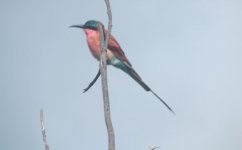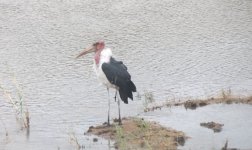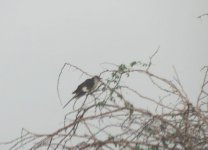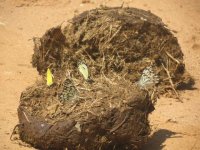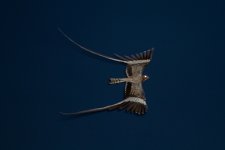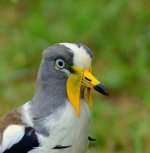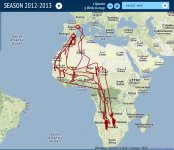Thanks for the comments folks. Both the Buffalo and Elephant that approached my car seemed to be just vaguely curious; the elephant wasn't twitching his ears, which I thought was a good sign.
27/2/14 cont.
Taking off from Shingwedzi I got my first sight of
White Backed Vultures wheeling around overhead, with one
Lappet Faced Vulture, showing the big difference in size.
A solitary
Black Crowned Chagra showed well.
In front of me on the road was a raptor which was clearly a harrier when it flew. I was advised later that it was likely to be a
Montagu's Harrier. In bushes to the right I saw my first
Black Cuckoo Shrike, which became commoner the further north I went, and a pair of Burchell's Coucal.
In some reeds there were
Sedge Warblers displaying (just as they do in Europe).
By a pond there was a Malachite Kingfisher, Jameson's Firefinch and Blue Waxbills.
I decided to press on towards Parfuri as it would be my only opportunity to see this changed ecosystem, with some unique birds. There was an abrupt change in habitat as trees changed from the low bush of the Open Savannah which is based on flat Basaltic soil that had been with me since I entered the park to what is called the ' Baobab Rugged Veld', with taller trees.
On the dirt road towards Parfuri Picnic Site I saw a
Brown Snake Eagle and my first
Meve's Starling, one of the species that are only seen around Parfuri.
At the picnic site beside the Luvulhu River, I met my first fellow tourists of the day, up until now I had the road to myself.
I met Frank, the well-known bird-expert ranger who is usually to be found there. Frank looked at my ID confusions on my camera and Id'ed the female Violet Starling which I'd thought was a thrush!
He brought me out of the shade into the intense heat to try and see a calling White Browed Scrub Robin. I glimpsed it briefly but couldn't tick it and we both withdrew to the shade as the heat was too much.
There were crocodiles lazily floating down-stream and a Common Sandpiper flew past.
I drove on towards Crooks Corner and began to see lots of European Bee-eaters, and my first of many
Broad Billed Rollers, another bird of the extreme north of the Kruger. A bronze coloured
Diderick's Cuckoo fed high in a tree. On the ground I saw
Village Indigobird and my first ever solitary
Red Billed Quelia, one of the most abundant birds on the planet!
At Crook's Corner where the Luvulhu meets the Limpopo river I got my first pair of
White Crowned Lapwing and
Red Billed Firefinch and a Fish eagle sat in a nearby tree. I went as far as the border crossing with Mozambique but didn't fancy dealing with border officials even though I had my passport on me.
Instead I headed back to Punda Maria Camp, about 35km south west.
When I got there I was disappointed not to find any birds at all apart from House Sparrows! There was a troupe of baboons and i wondered had they scared off the birds. I tried the start of the Mahonnie loop before the sun went down but didn't see anything new (European rollers everywhere of course).
Still, I had 21 lifers for the day. No point in being greedy, it was a hugely satisfying day.
View attachment 488092
View attachment 488093
View attachment 488091
